The purpose of this blog is threefold, provide a record of the project's progress for friends and family, share information about the project that may be useful to others who may be planning to undertake a project similar in concept and to help promote a better understanding of sustainability. Critiques, suggestions and comments are welcome.
To begin with, Shady Grove is the name for the project. Broomgrass is the name of the community where Shady Grove is being developed. Broomgrass is a 320 acre 19th century organic farm that is the basis for an alternative community development sensitive to the environment. Broomgrass is comprised of 16 one acre lots with the balance of the community owned land in a farm preservation trust. It is located in the panhandle of West Virginia in Berkley County near Martinsburg. http://www.broomgrass.com
We acquired our lot in September 2005. Our first task was to begin the process of finding an architect that would be a good fit with our philosophy and approach to the project and the end result. Finding an architect that is a good fit is the single most important step in the entire process. Wendy and I feel that we are tuned-in, creative and able to express and articulate our needs and dislikes so having an architect with the same sensibilities as an equal partner in the process was paramount.
I stumbled on an HGTV show that featured a strawbale dwelling designed by Sigi Koko. I googled her website at http://www.buildnaturally.com and contacted her to see if she was interested in hearing about our ideas. Wendy and I had an exploratory meeting with her to discuss the project at the conclusion of which we decided not to consider meeting with any other architects provided that Sigi accepted the project, which she did.
We began work with Sigi in September of 2006 and completed the planning phase of the project when permit ready plans were completed in June 2008. Yea, now what? Will it cost what we think it will and who will we get to build it? But life is full of interruptions...
We took a break from the project due to the economic meltdown in the fall of 2008; uncertain times dictated that we take a patient and cautious approach with the next step. We just hunkered down like most people, avoiding unnecessary risk and hoping not to be an unfortunate casualty like so many others. By August 2009 we felt the worst was over; we decided it was time to come out of our shell and move forward with the project.
The next step was to find a general contractor to construct the dwelling with the same high standard of craftsmanship, sense of aesthetic and importance of sustainability as ourselves and the architect. We decided to work with John in May 2009 anticipating a start sometime in the fall of 2009. The construction phase of the project got underway when the county building permit was issued in September 2009.
During the period of delay between the planning phase and construction phase we undertook some pre-construction activities in anticipation of some day moving forward with the project in earnest. We conducted a tree survey of the wooded lot to maximize the dwelling location and orientation for passive solar, grade slope, view and aesthetic while minimizing tree removal and ground disturbance detailed in the plans. All of this was calculated by the architect and included in the drawings because it is integral to the entire project.
We obtained the services of a forester/surveyor and conducted the tree survey by locating the position of all trees by species and variety that were 10" in diameter at 4' height. The next step was to obtain the services of a land clearing contractor to clear the wooded area for the footprint and orientation of the dwelling per the the plan specifications. The idea of clearing the lot raised some questions about how exactly the process works!
We then obtained the services of a local land clearing contractor with the experience and equipment to do the job. Using local tradesmen is one of the objectives of sustainable building and supports the local community. The approach to clearing is simply but methodically bulldozing over the trees to be removed. As part of the sustainable approach to the project, we anticipated the extraction of usable lumber from the standing trees.
Our architect suggested bringing a lumber mill to the site called a portable site mill to saw the logs. With this in mind, an experienced land clearing contractor goes a long way due to the risk of damage knocking down very large trees. As a tree is knocked down it wants to fall in a certain direction and takes everything in its path with it including limbs of other trees as well as whole trees. We wanted to minimize damage to the trees that would remain as well as those that had potential for lumber.
The diesel Case 1155E was roaring and John the operator with a prosthetic arm and hook (his arm was severed by the hydraulic compressor of a garbage truck when he was a young man; he said he swore he would never wear gloves again using heavy equipment) maneuvered the bulldozer as deftly as a kid playing with a Tonka toy. He was very knowledgeable about the species of each tree, its characteristics and its desire to fall in a certain direction based on any angle of lean, the grade slop, root crown, canopy size and shape and soil type and condition, all of which he knew intimately.
The fallen trees then had their limbs and exposed stump sawed off with chain saws by the crew in one area while the operator knocked down others. The logs were moved and staged for the portable site mill to saw them to the specifications of the lumber schedule. As with most construction activities you have to anticipate what is needed after each stage so the process moves along efficiently. I remember a saying I learned a long time ago which has served me well if remembered at the time, "most people don't have time to do it right but always find the time to do it twice".
A lumber schedule was developed by the architect to guide the site mill operator in extracting as much usable lumber from the fallen trees for use in the project as possible. With the assistance of the forester, we identified the following tree species and varieties for use: red oak, scarlet oak, black oak, white oak, chestnut oak, hickory, black walnut, Virginia pine and Table Mountain pine. Limbs and trunks that were not usable for construction lumber were sawed to 18" for use as fire wood and staged for splitting.
Seeing the site mill in operation was very interesting to say the least but seeing it arrive as a trailer pulled behind a pickup truck and unfolded like a mechanical creature like in the movie "Transformers" (I have only seen the movie trailer on TV) was impressive. The instant transformation of these huge trees of at least 80 years or more in age in a matter of minutes into 15' long 12"x 3" boards, was amazing.
The next step was to stack the lumber for air drying or curing and to protect it from the elements. I took on this task by erecting a wood and bamboo frame covered with a tarp that was tied down to withstand the elements (gale force winds and the like or so I thought). My brother Brendan suggested that the ends of the boards get a coat of paint. This would prevent or reduce the boards from cracking and checking due to different rates of drying on the ends of the boards during the natural seasoning process.
We used an old can of house paint one day to paint the ends of the boards as suggested. It was a beautiful summer day with an incredible sky of clouds. While I was painting Wallace and Avery played frisbee in the field and Wendy was taking some photographs of the clouds. She used the images she captured for a reference to do a drawing titled "High Clouds Over Broomgrass" that was awarded "best in show" at The Art League located in the Torpedo Factory in Alexandria VA.
Saturday, December 5, 2009
Subscribe to:
Post Comments (Atom)



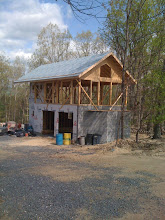

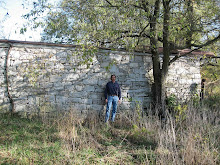
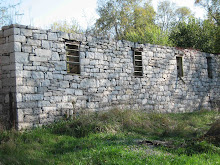





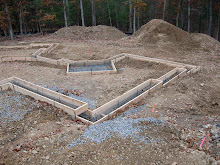

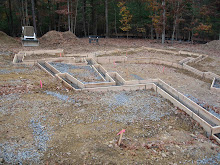
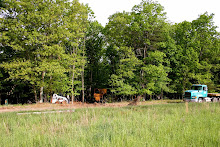
















No comments:
Post a Comment